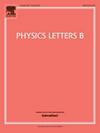QCD equation of state at finite μB using deep learning assisted quasi-parton model
IF 4.5
2区 物理与天体物理
Q1 ASTRONOMY & ASTROPHYSICS
引用次数: 0
Abstract
To accurately determine the nuclear equation of state (EoS) at finite baryon chemical potential () remains a challenging yet essential goal in the study of QCD matter under extreme conditions. In this study, we develop a deep learning assisted quasi-parton model, which utilizes three deep neural networks, to reconstruct the QCD EoS at zero and predict the EoS and transport coefficient at finite . The EoS derived from our quasi-parton model shows excellent agreement with lattice QCD results obtained using Taylor expansion techniques. The temperature of smallest is found to be approximately 175 MeV and decreases with increasing chemical potential within the confidence interval. This model not only provides a robust framework for understanding the properties of the QCD EoS at finite but also offers critical input for relativistic hydrodynamic simulations of nuclear matter produced in heavy-ion collisions by the RHIC beam energy scan program.
利用深度学习辅助准parton模型求解有限μB处的QCD状态方程
精确地确定有限重子化学势(μB)下的核态方程(EoS)是极端条件下QCD物质研究中一个具有挑战性但又必不可少的目标。在这项研究中,我们建立了一个深度学习辅助的准parton模型,利用三个深度神经网络来重建零μB下的QCD EoS,并预测有限μB下的EoS和输运系数η/s。由拟部分子模型导出的方程组与使用泰勒展开技术得到的晶格QCD结果非常吻合。最小η/s温度约为175 MeV,在置信区间内随化学势的增大而减小。该模型不仅为理解有限μB下QCD粒子的性质提供了一个强有力的框架,而且为RHIC束流能量扫描程序在重离子碰撞中产生的核物质的相对论流体动力学模拟提供了关键输入。
本文章由计算机程序翻译,如有差异,请以英文原文为准。
求助全文
约1分钟内获得全文
求助全文
来源期刊

Physics Letters B
物理-物理:综合
CiteScore
9.10
自引率
6.80%
发文量
647
审稿时长
3 months
期刊介绍:
Physics Letters B ensures the rapid publication of important new results in particle physics, nuclear physics and cosmology. Specialized editors are responsible for contributions in experimental nuclear physics, theoretical nuclear physics, experimental high-energy physics, theoretical high-energy physics, and astrophysics.
 求助内容:
求助内容: 应助结果提醒方式:
应助结果提醒方式:


